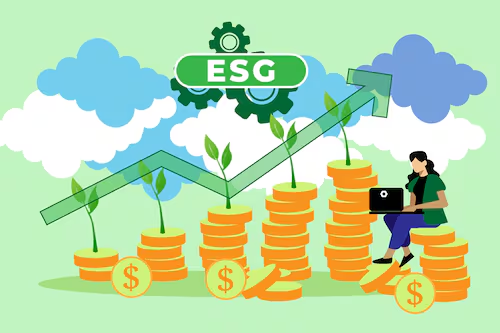Environmental, Social, and Governance (ESG) investing has gained traction in India, with over $4 billion in ESG-focused funds by 2024, driven by SEBI’s Business Responsibility and Sustainability Reporting (BRSR) and Stewardship Code. As India’s startup ecosystem grows, with 1.74 lakh DPIIT-recognized startups contributing ₹3.5 lakh crore to GDP, ESG integration offers family offices and high-net-worth individuals (HNIs) a chance to align wealth with long-term sustainability. Drawing on Soumya Rajan’s insights, this article examines whether ESG investing is a passing trend or a lasting strategy, its benefits for risk management, and actionable steps for Indian investors in 2025, particularly in listed and unlisted markets.
Is ESG Investing a Fad or Here to Stay?
ESG investing integrates environmental (e.g., carbon emissions), social (e.g., labor practices), and governance (e.g., board diversity) factors into investment decisions to enhance risk-return profiles while supporting sustainability. Globally, ESG assets under management reached $40 trillion in 2024, with 90% of S&P 500 companies publishing sustainability reports. In India, ESG funds grew 20% YoY, managing ₹50,000 crore by Q2 2025, per AMFI.
Arguments for ESG as a Fad
- Greenwashing Concerns: 60% of Indian investors cite inconsistent ESG metrics as a barrier, per a 2024 IIC survey, risking inflated claims without measurable impact.
- Short-Term Costs: ESG compliance (e.g., BRSR reporting) increases costs by 2–5% for SMEs, deterring smaller firms.
- Market Volatility: Post-COVID, 30% of ESG funds underperformed broader indices in 2022 due to energy sector volatility, raising doubts about consistency.
Arguments for ESG’s Longevity
- Regulatory Push: SEBI’s mandatory BRSR for top 1,000 listed companies (from FY23) and Stewardship Code (July 2020) enforce transparency, with 85% compliance by 2024. GIFT City’s ESG tax incentives (e.g., 10-year tax holidays) further mainstream adoption.
- Risk Mitigation: ESG integration reduces exposure to systemic risks like climate change (e.g., ₹1.5 lakh crore in flood-related losses by 2030) and governance failures (e.g., 40% of 2022 unicorn valuation cuts tied to poor governance).
- Performance Edge: MSCI India ESG Leaders Index outperformed the MSCI India Index by 200–300 basis points annually since 2007, with a Sharpe Ratio of 1.2 vs. 0.9.
- Investor Demand: 42% of Asia-Pacific family offices allocate 29% of portfolios to ESG, per Campden 2022, driven by Next-Gen focus on sustainability.
Verdict: ESG is here to stay, driven by regulatory mandates, investor demand, and proven risk-adjusted returns. India’s 2070 net-zero goal and UN SDG commitments ensure ESG’s integration into mainstream investing.
Benefits for Family Offices and HNIs
India’s 300+ family offices (managing ₹108 lakh crore) and 85,698 HNIs can leverage ESG for:
- Risk Management: ESG metrics flag risks like regulatory fines (e.g., ₹10,000 crore in environmental penalties in 2024) and supply chain disruptions (e.g., 20% cost hikes during COVID).
- Market Returns: ESG funds delivered 12–15% IRRs in renewable energy and healthcare, per IIC, matching conventional funds.
- Legacy Building: Aligns with Next-Gen values, with 60% of Indian HNIs under 40 prioritizing sustainable investments in 2024.
- Tax Benefits: DPIIT-recognized startups in ESG sectors (e.g., CleanTech) offer 100% tax deductions under Section 80-IAC for three years.
Example: A Mumbai-based family office invested ₹50 crore in a renewable energy AIF, achieving 14% IRR and reducing 10,000 tonnes of CO2 annually.
ESG Integration in Indian Markets
Listed Investments
- BRSR Compliance: 900 of India’s top 1,000 listed companies published BRSRs in 2024, disclosing ESG metrics like emissions (e.g., Tata Steel reduced CO2 by 15% YoY) and diversity (e.g., Infosys’ 40% women workforce).
- Stewardship Code: Mutual funds with ₹25 lakh crore AUM engage investee companies on governance, improving board accountability (e.g., 20% rise in independent directors since 2020).
- Tools: MSCI and Sustainalytics provide ESG risk scores, with top performers like HDFC Bank (MSCI AAA) yielding 10% higher returns than peers.
Action: Allocate 20–30% of portfolio to ESG-focused mutual funds (e.g., SBI ESG Equity Fund) within 6 months, using MSCI scores to select top-quartile firms.
Unlisted Investments
- Impact Startups: 2,800 DPIIT-recognized AgriTech and CleanTech startups raised $2.4 billion in 2024, offering 12–18% IRRs in sectors like precision farming and EV batteries.
- Blended Finance: Development Impact Bonds (DIBs) and loan guarantees leverage 3–5x commercial capital, de-risking investments in social enterprises.
- Example: Caspian Impact Investments’ ₹100 crore fund in Veritas Finance scaled SME lending, serving 51,000 clients with 15% returns.
Action: Invest 10–15% in unlisted ESG startups via AIFs or angel networks within 90 days, leveraging DPIIT’s 80% patent fee rebates.
Challenges and Solutions
- Challenges:
- Greenwashing: Inconsistent ESG metrics lead to 30% of funds misreporting impact, per a 2024 EY study.
- Skill Gaps: Only 25% of impact funds have ESG-trained managers, per IIC.
- Deal Flow: Limited high-quality ESG opportunities in unlisted markets (20% of total VC deals).
- Solutions:
- Adopt IRIS+ or GIIN frameworks for standardized impact measurement within 60 days.
- Partner with advisors like Waterfield Advisors for due diligence and deal sourcing.
- Leverage Startup India’s Investor Connect for access to 1,200+ ESG startups annually.
Conclusion
ESG investing is no fad—it’s a lasting strategy driven by SEBI regulations, global investor demand, and proven risk-adjusted returns (200–300 bps outperformance). For India’s family offices and HNIs, ESG offers 12–18% IRRs in listed (e.g., ESG mutual funds) and unlisted (e.g., CleanTech startups) markets while addressing climate and social challenges. Start by allocating 20–30% to ESG funds and 10–15% to impact startups within 6–12 months, using MSCI/Sustainalytics scores and DPIIT benefits (e.g., tax exemptions). Partner with advisors to navigate greenwashing and source deals via Startup India’s Investor Connect. As custodians of future wealth, integrating ESG ensures sustainable returns and a legacy aligned with India’s 2070 net-zero vision.
Disclaimer: This article is for educational purposes and does not constitute financial or legal advice. Consult certified advisors and verify details with SEBI, DPIIT, or tax authorities.

